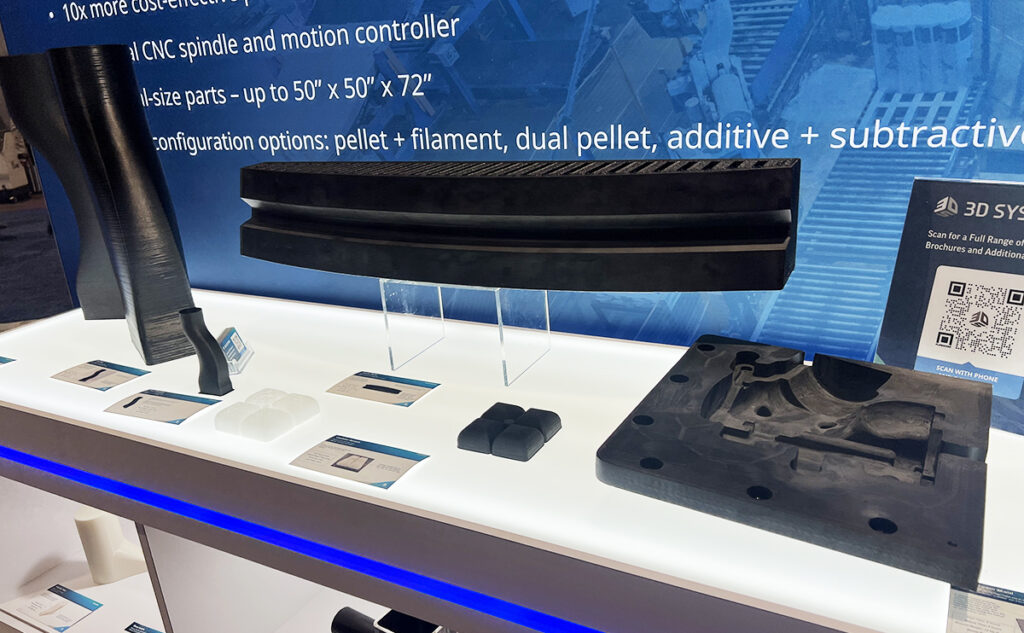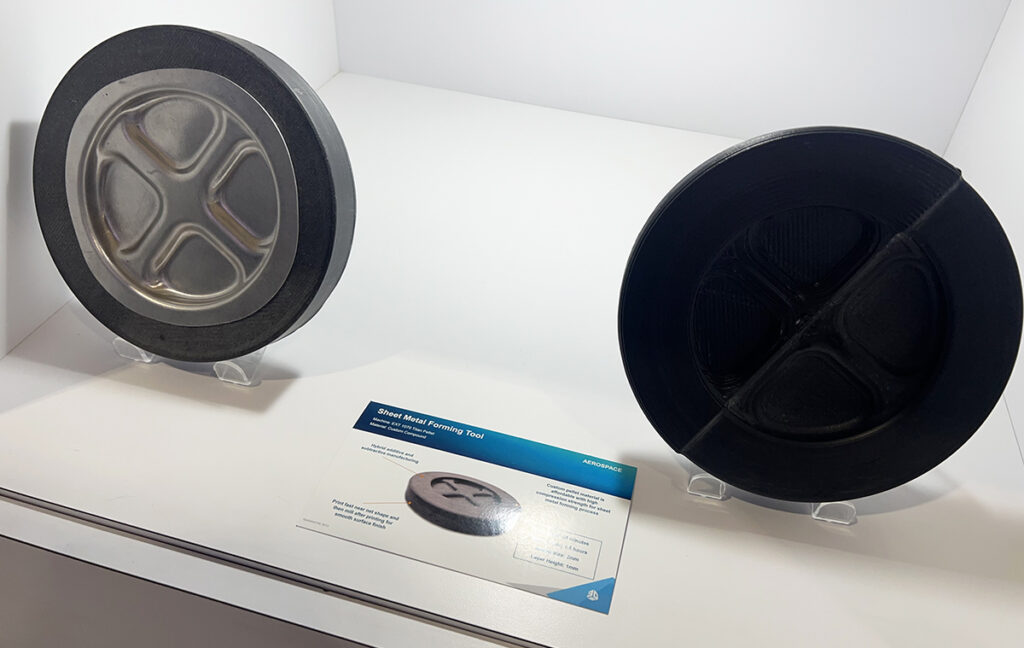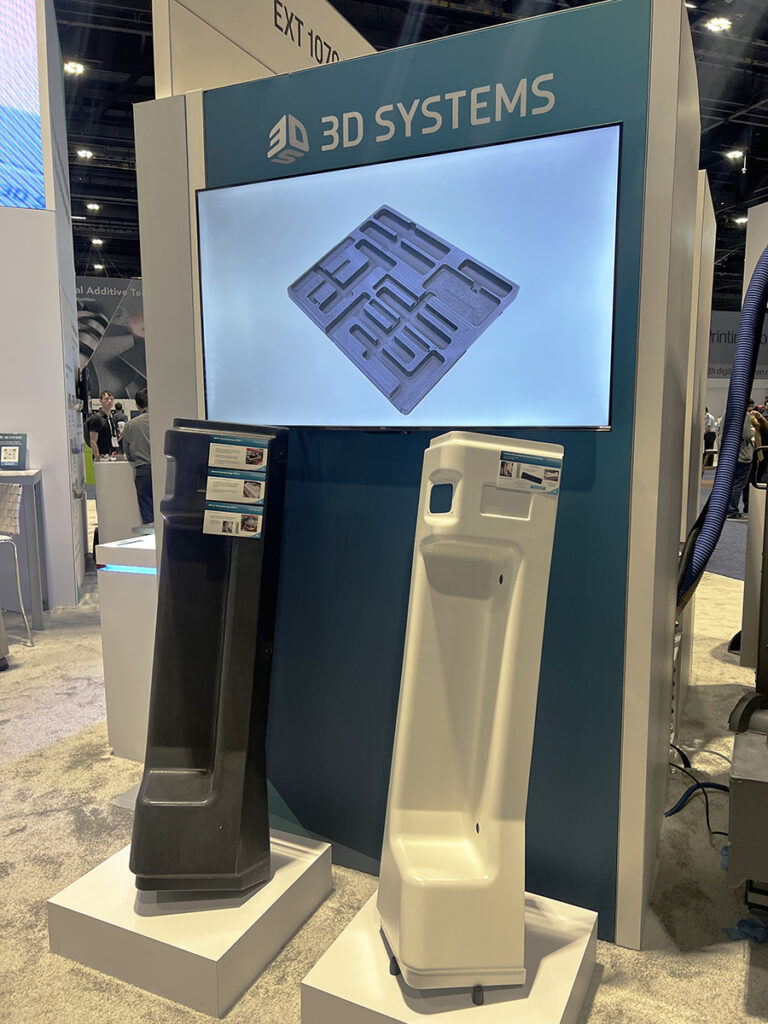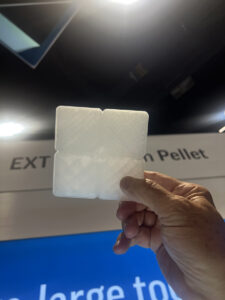When it comes to large-format polymer 3D printing, there are a growing number of options, particularly for industrial robotic arms. However, most options on the market don’t tackle all of the necessary variables for additive manufacturing (AM) plastics. After speaking to Brad Mount, Global Director of Business Development – Titan, 3D Systems, at RAPID + TCT 2023, I came away thinking that the 3D Systems (NYSE: DDD) division had really thought of everything for 3D printing big polymer parts.
Versatility in the Large-scale 3D Printers
What’s most interesting about 3D Systems’ extrusion printers – is their flexibility. The material extrusion machines are available in two sizes, the EXT 1070 Titan Pellet (formerly the Titan Atlas 2.5) with a build volume of 42” x 42” x 48” and the even larger EXT 1270 Titan Pellet (formerly the Titan Atlas 3.6) with a build envelope of 50” x 50” x 72”. To produce parts that large, both printers rely primarily on pellet extrusion, increasing print speed and lowering overall material costs by using standard injection molding pellets.

Various parts 3D printed with the Titan Atlas displayed at RAPD + TCT 2023.
However, either system can be outfitted with up to three toolheads, including filament extrusion for more detailed parts, a second pellet extruder or even a three-axis CNC milling toolhead for better surface finish. 3D Systems EXT Titan Pellet printers can have several variations of toolhead configurations, such as two filament extruders and one pellet extruder, two pellet extruders and a single filament extruder or a filament extruder, pellet extruder and a three-axis CNC milling toolhead all on a single gantry. With multiple extruders, a water-soluble support material can be deposited alongside a polymer, or rigid and flexible materials can be combined, even when printing with pellets. For systems with a three-axis CNC milling spindle, milling can be performed at any point during fabrication so that a part can be milled mid-print or at the end of a job.
“I work with a lot of commercial [original equipment manufacturers], as well as the defense community,” said Mount. “When I’ve talked with someone from the Army, Navy, or Air Force, they love the combination of milling with additive in the same footprint. It’s hard to believe, but a lot of DoD sites have very limited floor space, so if they can get two machines in one instead of taking up more space, that’s huge.”
In addition to a variety of choices in toolheads, 3D Systems’ EXT Titan Pellet printers can also swap out a number of different nozzles, ranging from .6mm all the way up to 9 mm. Such a large nozzle diameter wouldn’t make much sense on a desktop 3D printer, but for the massive EXT Titan Pellet series, it means producing thicker layers very quickly before the mill head shaves it down to spec. One part on display at RAPID was a sheet metal forming tool for Tinker Air Force Base. The component, printed with a 2mm nozzle and finished with the spindle toolhead, allowed engineers to replace an obsolete part for aging aircraft.

A 3D printed sheet metal forming tool for Tinker Air Force Base.
Throughout the tour of the 3D Systems booth, Mount highlighted large parts, such as a large 3D printed air duct, and compared the pace with which the EXT Titan Pellet machine made it with how quickly a standard filament extrusion machine could do it. In the case of the air duct, traditional fused deposition modeling users estimated it might take three days, in contrast to the eight hours the EXT Titan produced it.
In addition to the sheer speed of the printers, a key highlight of the EXT Titan Pellet series is the ability to 3D print with a variety of materials. This includes fiber reinforced high-temperature plastics like GF-PEKK, CF-PEKK and CF-PEI pellets. This sets 3D Systems’ enormous pellet extrusion printers apart from many other large-format polymer printers, which typically don’t maintain chamber or nozzle temperatures hot enough for such materials. One customer used a 30 percent glass fiber-reinforced PEKK to 3D print a fixture for welding multiple metal parts together.

A welding tool 3D printed from high-temperature reinforced plastic.
Large-Scale 3D Printed Tooling
Another novel application Mount showcased was a tool that had the built-in benefit of porosity for enhanced airflow for vacuum forming. Whereas with traditional vacuum forming molds it’s necessary to drill holes to allow the system to pull in air, thus shaping the end polymer part around the tool, extrusion 3D printing’s inherent porosity eliminates the need to drill holes to provide the vacuum needed for the thermoforming process. Moreover, by controlling the infill of the printed mold, it’s possible to control the force of the vacuum. Demonstrating the possibilities at the trade show was a plastic panel thermoformed using a Titan printed mold for installation on a subway train.

A 3D printed titan mold (left) alongside a white thermoformed part (right).
Mount laid out the cost and time benefits of traditional thermoforming tool production and that of 3D printing:
“Traditionally, they either use what’s called Ren board, in which sheets of wood are glued together, stacked, and machined. They may also perform casting and then machine the casting, or they might just CNC a block of aluminum for the tool. All of those are expensive and very time consuming. The lead time for those traditional processes is typically four to 10 weeks. [With our machine], they can 3D print this tool in a day and start thermoforming parts,” Mount said. “That’s value to their customers and, for them, it’s a competitive advantage for lead time and cost. What we’re seeing in thermoforming is up to 80 percent cost reduction and about a 65 percent lead time reduction.”
Similar properties and techniques that enhance porosity in a vacuum molding tool also allow for the manipulation of cushioning in a flexible part. Mount explained that one visitor of the 3D Systems booth was interested in 3D printing headrests for a vehicle, potentially modifying the density of printed TPU to vary the shore hardness throughout the component. This could lead to customer-specific seating for wheelchair users, among other applications.
- Brad Mount holding up a 3D printed TPU part made with an Atlas machine.
- The light passing through the TPU part shows the varying infill densities within the part, providing varying levels of cushion.
3D Systems’ Material Extrusion Bet
Speaking with Mount, it was clear that 3D Systems’ entry into material extrusion technology was carefully thought out. When the company acquired Kumovis and Titan Robotics, it wasn’t simply expanding its machine portfolio to include one of AM’s most popular categories of 3D printing. These were strategic moves to compete directly with material extrusion leader Stratasys, among others.
Whereas Stratasys has an established array of filament extrusion machines for industrial and aerospace prototyping and production, 3D Systems has now tackled niches that the FDM inventor had previously neglected. With Kumovis, it has medically cleared 3D printing for point-of-care parts. With Titan, it has rapid, large-format extrusion under its belt. These are extremely unique varieties of material extrusion that address very specific applications that other players have missed, making 3D Systems’ foray into the space a potentially profitable one.
Subscribe to Our Email Newsletter
Stay up-to-date on all the latest news from the 3D printing industry and receive information and offers from third party vendors.
Print Services
Upload your 3D Models and get them printed quickly and efficiently.
You May Also Like
Johns Hopkins University Researchers Develop HyFAM Technology
Two scientists from Johns Hopkins University, Nathan C. Brown and Jochen Mueller, have developed a hybrid manufacturing technology they call HyFam, or Hybrid Formative Additive Manufacturing. Their work on this technology...
3D Printing G-Code Gets an Upgrade: T-Code
Good old G-Code still manages many 3D printers, great and small. Just like the STL, it’s a standard that enables collaboration while also holding the additive manufacturing (AM) industry back....
AM Rewind: The Biggest News and Trends of 2024
After a sluggish 2023, driven by persistent inflation and geopolitical tensions, 2024 has seen some recovery. Economic growth climbed from about 2.8 percent in 2023 to a modest 3.2 percent...
Metal Wire 3D Printer OEM ValCUN Announces Plans for 2025 Expansion
ValCUN, a Belgian original equipment manufacturer (OEM) of wire-based metal additive manufacturing (AM) hardware, has announced that the company has entered the next phase of its growth trajectory, making key...



































